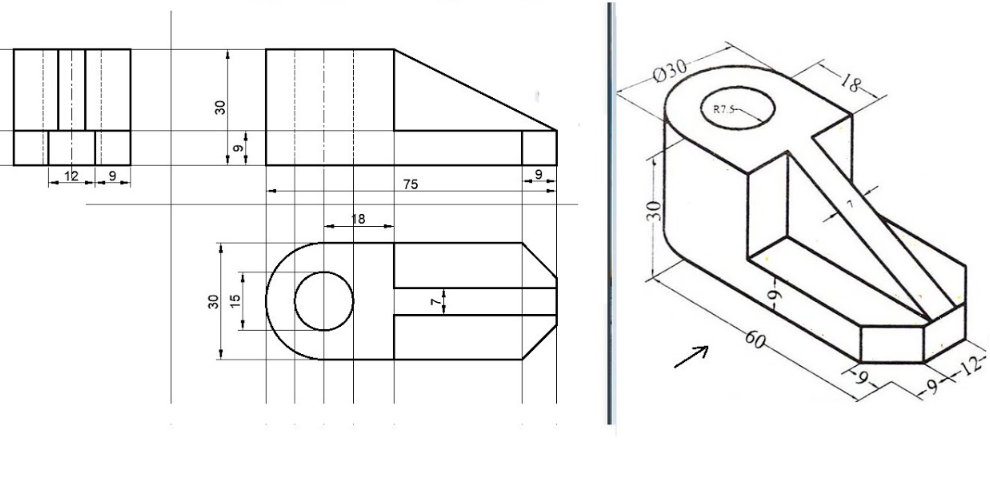The façade is typically the most well-known element of a technical drawing. It provides one of the most helpful perspective of a things, catching its elevation and width while covering depth. This view is normally the very first drawing to be developed and offers as the reference factor for establishing additional views. The primary objective of the front view is to supply a clear, simple depiction of the item that emphasizes important features, measurements, and proportions. This sight stabilizes the drawing procedure, enabling developers to work from this standard point of view, making certain that subsequent views straighten properly which all featuresline up as meant.
Building upon this, the leading sight matches the front sight by providing info concerning the depth of the item. This sight permits designers to see exactly how large and deep the object is, getting rid of uncertainty that might arise from the initial front sight alone.
The side view, also understood as the account sight, uses yet an additional perspective by depicting the object's height and depth. It is especially beneficial for showcasing features that may not be as noticable in the front or leading views. By integrating the side sight right into the technical drawing, developers make certain that all measurements can be accurately presented, creating an extensive view of the item. The side view can highlight shapes, inclines, or any kind of outcroppings that might be substantial to the layout's functional efficiency and visual allure.
Explore technical drawing views the essential role of technical drawing in design and style, highlighting vital views such as front, top, side, area, and isometric viewpoints that make sure exact communication and execution in style and manufacturing.
Area views are another vital part of technical drawings. They provide a means to illustrate the internal attributes of a style that might not be apparent from the exterior views. An area view is developed by cutting through the things and subjecting its internal geometry.
This view supplies a three-dimensional representation of the things, providing a practical illusion of deepness and scale without needing intricate point of view estimations. Isometric views can be extremely valuable in communicating the total layout of a things, especially to people that may not be fluent in reading technical illustrations.
In enhancement to these essential views, there are numerous other types of forecasts, such as orthographic and perspective forecasts, that offer different features in technical drawing. Orthographic estimates are a collection of several views that independently portray the item from various angles, generally in a two-dimensional layout. This method enables each facet of the drawing to be minimized or made best use of as needed, making certain clarity in specs and reducing the danger of false impression. Point of view illustrations, conversely, goal to create an illusion of deepness and dimension, simulating just how the human eye perceives the globe. Although these drawings can be less specific than orthographic projections because of their dependence on vanishing points and visitor perspective, they can catch the visual qualities of a style, making them valuable in marketing or conceptual discussions.

To successfully create a technical drawing, it is important to understand the conventions and symbols that represent different features and dimensions. Inaccurate measurements can lead to pricey blunders throughout production, making this facet of technical drawing critical for integrity and success.
In addition, numerous software program devices and applications assist in the technical drawing process, improving the conventional hand-drawing methods. Programs like AutoCAD, SolidWorks, and other Computer-Aided Design (CAD) software allow customers to develop complex 2D and 3D designs with far greater precision and adaptability than hand-operated methods. These tools enable easy alterations, permitting fast prototyping and version without the need to recreate drawings from the ground up. This electronic makeover has actually dramatically sped up the style and production processes throughout countless sectors, driving advancement and improving efficiency.
In the context of markets today, comprehending how to use various views in technical drawing is not only essential for engineers and designers but also for suppliers, product designers, and also marketing professionals. The capability to communicate intricate ideas simply and plainly through these visual depictions helps to straighten teams, from concept via to production. In collaborative settings, especially in areas like building and manufacturing, clear technical illustrations guarantee that all stakeholders-- from designers to customers-- are on the very same page. This collaboration is necessary for mitigating errors and lowering waste, eventually preserving time and sources while fostering creative thinking in the advancement of originalities.
With the rise of 3D printing and additive production, the importance of exact technical drawing becomes also extra noticable. As these modern technologies continue to advance, they need thorough specs to make certain that physical designs properly embody the initial design. The capability to from comprehensive technical illustrations, consisting of several views, is crucial for producing components that not only mesh correctly however additionally operate effectively as part of wider systems. In addition, as industries shift to computerized and digital processes, the abilities needed to create and analyze technical drawings will certainly be critical to future skill pipes.
In final thought, technical drawing includes different views, each of which plays a particular function in conveying required information about an item. As innovation and approaches for creating technical drawings continue to breakthrough, understanding and applying these views properly continues to be vital. As we move even more into an era identified by quick technical development, the principles of technical drawing and its accompanying views will undoubtedly remain essential in forming the future of production, engineering, and design.